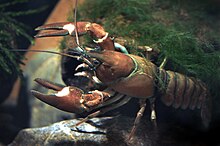Pacifastacus leniusculus
| Pacifastacus leniusculus | |
|---|---|
 |
|
| Scientific classification | |
| Kingdom: | Animalia |
| Phylum: | Arthropoda |
| Subphylum: | Crustacea |
| Class: | Malacostraca |
| Order: | Decapoda |
| Family: | Astacidae |
| Genus: | Pacifastacus |
| Species: | P. leniusculus |
| Binomial name | |
|
Pacifastacus leniusculus (Dana, 1852) |
|
The signal crayfish, Pacifastacus leniusculus, is a North American species of crayfish. It was introduced to Europe in the 1960s to supplement the Scandinavian Astacus astacus fisheries, which were being damaged by crayfish plague, but the imports turned out to be a carrier of that disease. The signal crayfish is now considered an invasive species across Europe and Japan, ousting native species there.
Members of this species are typically 6–9 centimetres (2.4–3.5 in) long, although sizes up to 16–18 cm (6.3–7.1 in) are possible. They are bluish-brown to reddish-brown in colour with robust, large, smooth claws. They have a white to pale blue-green patch near the claw hinge, like the white flags that signalmen used for directing trains—hence the name.
The life cycle of the signal crayfish is typical for the family Astacidae. Around 200–400 eggs are laid after mating in the autumn, and are carried under the female's tail until they are ready to hatch the following spring. The eggs hatch into juveniles, which pass through three moults before leaving their mother. Sexual maturity is reached after two to three years, and the life span can be up to 20 years.
The signal crayfish is an omnivore, with most of its dietary intake being detritus.
The signal crayfish is native to North America west of the Rocky Mountains, including the Canadian province of British Columbia, and the U.S. states of Washington, Oregon, and Idaho. It was introduced to California in 1912 into the San Lorenzo River watershed and from there rapidly spread throughout the state. The only native crayfish remaining in California is the Shasta crayfish (Pacifastacus fortis), where efforts are being made to create a barrier to Signal crayfish invasion. Within North America, it has also been introduced to Nevada, and the populations in Utah may be the results of introductions. It has also been found in Alaska, specifically Kodiak Island, in the Buskin River and BuskinLake. It is listed as a species of Least Concern on the IUCN Red List.
...
Wikipedia

